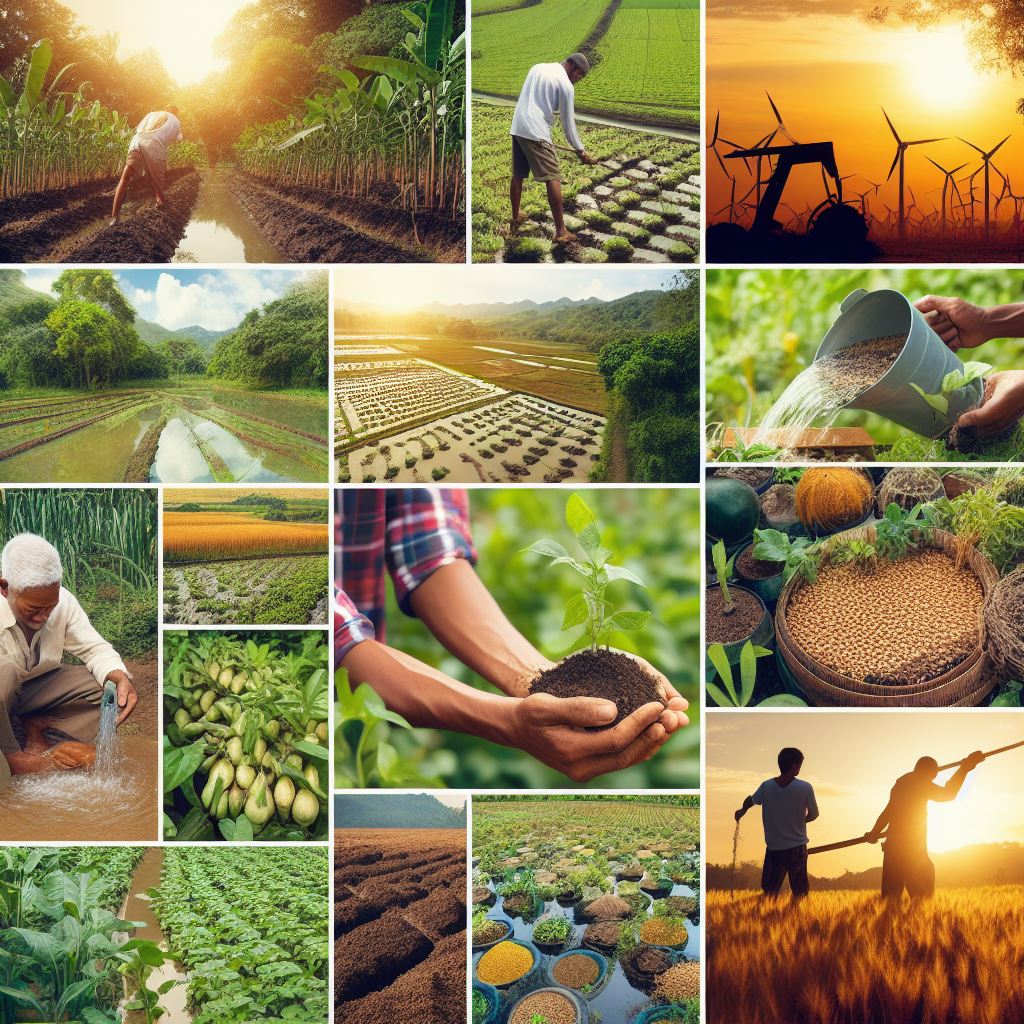Introduction
Livestock Farming Adapting to Climate Shifts is an integral part of our agricultural system, providing us with essential resources such as meat, milk, and eggs.
The industry not only contributes to food security but also plays a crucial role in economic growth and rural development.
However, climate shifts have emerged as a major concern for livestock farmers worldwide.
The impact of climate shifts on livestock farming cannot be underestimated.
Rising global temperatures, unpredictable weather patterns, and extreme events like droughts and floods pose a severe threat to animal health, livestock production, and overall farm sustainability.
Livestock often struggle to cope with these changes, leading to diseases, reduced fertility, and even death.
Additionally, the quality and availability of feed and water, two crucial components of animal nutrition, are also affected by climate shifts.
This blog post aims to shed light on the challenges faced by livestock farmers due to climate shifts and explore potential strategies for adaptation.
By understanding these challenges, we can work towards implementing sustainable practices and resilient systems to mitigate the impacts of climate shifts.
It is imperative for farmers to stay updated with current scientific research and technological advancements to make informed decisions in managing their livestock farms.
In short, this blog post will discuss the importance of livestock farming, the impact of climate shifts on the industry, and the purpose of this writing.
By addressing these topics, we hope to raise awareness and encourage proactive measures to ensure the resilience and sustainability of livestock farming in the face of climate shifts.
Climate Shifts and Livestock Farming
Explanation of climate shifts
Climate shifts refer to long-term changes in weather patterns and temperature conditions in a specific region.
Discussion on how climate shifts affect livestock farming
1. Changes in temperature and precipitation patterns
Climate shifts can lead to unpredictable weather patterns, including increased temperatures and altered rainfall patterns.
These changes directly affect livestock farming as they impact the availability of suitable grazing areas and the growth of forage crops.
Transform Your Agribusiness
Unlock your farm's potential with expert advice tailored to your needs. Get actionable steps that drive real results.
Get Started2. Extreme weather events
Climate shifts can cause an increase in the frequency and intensity of extreme weather events such as hurricanes, droughts, floods, and heatwaves.
These events pose significant challenges to livestock farmers as they can result in infrastructure damage, loss of livestock, and disruption of feed and water supplies.
3. Impact on forage availability
Climate shifts can disrupt the growth and quality of forage crops, affecting their availability and nutritional value.
Livestock heavily depend on forage for their dietary needs, so any changes in forage availability can have a detrimental impact on their health and productivity.
Livestock farmers need to adapt their practices to mitigate the effects of climate shifts and safeguard their operations.
Adapting to Climate Shifts
Implementing sustainable management practices
Livestock farmers can adopt practices that emphasize sustainable land management and forage production.
This may involve implementing rotational grazing systems, conserving water resources, and using cover crops to improve soil health and water retention.
Improved infrastructure and housing
Investing in infrastructure that can withstand extreme weather events is crucial.
Sturdy shelters, drainage systems, and secure fencing can protect livestock from extreme temperatures, heavy rainfall, and high winds.
Diversifying livestock breeds and species
Climate shifts may make certain livestock breeds vulnerable to heat stress or disease.
By diversifying the breeds and species they rear, farmers can increase resilience to changing climatic conditions and reduce the risk of negative impacts on their operations.
Developing emergency preparedness plans
Livestock farmers should have contingency plans in place to address sudden weather crises.
These plans can include strategies for emergency evacuation, stockpiling of feed and water, and protocols for providing veterinary care during extreme events.
Enhancing monitoring and early warning systems
Continuous monitoring of weather patterns and climate forecasts can help livestock farmers make informed decisions about managing their herds.
Early warning systems can alert farmers to impending extreme weather events, allowing them to take preventive measures and minimize potential losses.
In essence, climate shifts have a profound impact on livestock farming, affecting forage availability, animal health, and overall farm productivity.
However, by implementing adaptation strategies and adopting sustainable practices, livestock farmers can mitigate the risks posed by climate shifts and ensure the long-term sustainability of their operations.
Read: Carbon Farming: Agriculture’s Climate Promise
Adapting Livestock Farming to Climate Shifts
Improved breed selection
- Selecting breeds resilient to changing weather patterns.
- Breeding for heat tolerance.
Changes in animal management practices
- Providing shade and proper ventilation.
- Implementing water management techniques.
Altering feeding strategies
- Adjusting feeding patterns based on changing forage availability.
- Evaluating alternative feed sources.
Implementing sustainable grazing practices
- Practicing rotational grazing.
- Adopting managed intensive grazing.
Livestock farming, an essential aspect of global food production, faces numerous challenges due to climate shifts.
As extreme weather events become more frequent, it is crucial for farmers to adapt their practices by implementing strategies that promote the well-being of their animals and ensure the sustainability of their operations.
Improved breed selection
Selecting breeds resilient to changing weather patterns is crucial in minimizing the negative impacts of climate shifts.
By choosing animals that can tolerate higher temperatures, resist diseases, and adapt to fluctuating forage availability, farmers can reduce the vulnerability of their livestock to environmental stressors.
Breeding for heat tolerance can further enhance the resilience of the herd, ensuring their productivity and overall health.
Changes in animal management practices
To mitigate the adverse effects of climate shifts, farmers must make changes in their animal management practices.
Showcase Your Farming Business
Publish your professional farming services profile on our blog for a one-time fee of $200 and reach a dedicated audience of farmers and agribusiness owners.
Publish Your ProfileProviding ample shade and proper ventilation in livestock housing structures can help animals cope with extreme heat and maintain their wellbeing.
In addition, implementing water management techniques such as efficient irrigation systems and proper water storage can address water scarcity and ensure animals have access to sufficient water throughout the year.
Altering feeding strategies
Changes in forage availability due to climate shifts can significantly impact livestock nutrition.
Farmers must adjust their feeding patterns based on the changing availability of forage, ensuring that animals receive adequate nutrition for optimal growth and productivity.
Furthermore, evaluating alternative feed sources such as using drought-resistant crops or exploring innovative feeding techniques can help maintain the nutritional requirements of the herd even during challenging climatic conditions.
Implementing sustainable grazing practices
Adopting sustainable grazing practices is vital for livestock farmers to adapt to climate shifts and promote environmental stewardship.
Rotational grazing, which involves dividing pastures into smaller sections and rotating livestock, allows for the regeneration of vegetation and prevents overgrazing.
Managed intensive grazing, on the other hand, focuses on maximizing forage utilization by strategically moving livestock through smaller grazing areas with higher stocking densities.
Both practices promote soil health, improve forage production, and enhance carbon sequestration.
Basically, climate shifts pose significant challenges to livestock farming, but proactive adaptation strategies can help farmers mitigate their impacts.
Improved breed selection, changes in animal management practices, altering feeding strategies, and implementing sustainable grazing practices are key measures that farmers can adopt to ensure the resilience and sustainability of their livestock operations amidst changing environmental conditions.
By embracing these adaptive practices, livestock farmers can thrive even in the face of climate shifts and continue to provide vital resources to meet global food demand.
Read: Climate-Proof Crops: The Genetic Engineering Angle

Technological Innovations for Resilient Livestock Farming
Use of precision agriculture technologies
- Weather monitoring systems
- Sensors for animal health monitoring
Adoption of genetic technologies
- Genetic markers for climate resilience
- Genetically modified feed options
Utilizing renewable energy sources
- Solar panels for powering farm operations
- Biogas production from livestock waste
As climate shifts continue to impact livestock farming, technological innovations play a crucial role in ensuring a resilient and sustainable industry.
These advancements not only help farmers adapt to changing environmental conditions but also enhance productivity and animal well-being.
Use of precision agriculture technologies
1. Weather monitoring systems
By employing weather monitoring systems, farmers can gain real-time information about temperature, humidity, rainfall, and wind conditions.
This data enables them to make informed decisions regarding animal housing, feed management, and disease prevention.
For instance, during extreme temperature events, such as heatwaves, farmers can adjust cooling systems or provide shade for animals.
2. Sensors for animal health monitoring
Utilizing sensors placed on animals allows farmers to continuously monitor their health and well-being.
These sensors can track vital signs, detect early signs of illnesses, and monitor individual feed intake.
By identifying health issues and addressing them promptly, farmers can prevent disease outbreaks and reduce the need for antibiotics, leading to improved herd health and productivity.
Adoption of genetic technologies
1. Genetic markers for climate resilience
Through genetic advancements, researchers have identified specific markers associated with climate-resilient traits in livestock.
By selectively breeding animals with these traits, farmers can develop herds better adapted to changing environmental conditions.
This includes traits like heat tolerance, resistance to diseases influenced by climate, and efficient nutrient utilization.
Breeding for climate resilience enhances the overall adaptability and performance of livestock.
2. Genetically modified feed options
Genetic technologies also enable the modification of feed options to better suit the nutritional needs of animals in a changing climate.
Scientists can develop genetically modified crops that are drought-resistant, have higher nutrient content, or are better suited for specific environmental conditions.
This allows farmers to provide optimal feed, ensuring the health and productivity of their livestock even in challenging climate scenarios.
Utilizing renewable energy sources
1. Solar panels for powering farm operations
Installing solar panels on livestock farms can provide a sustainable and reliable source of energy.
Solar power can be used to operate electric fences, lighting, water pumps, and ventilation systems.
By reducing dependence on non-renewable energy sources, farmers can minimize their carbon footprint and cut down on operational costs, making their farms more environmentally friendly and economically viable.
2. Biogas production from livestock waste
Another renewable energy option is the utilization of biogas produced from livestock waste through anaerobic digestion.
Biogas can be used for various purposes, such as heating, electricity generation, or fuel for vehicles.
By harnessing this energy source, farmers can reduce their reliance on fossil fuels, manage waste effectively, and contribute to a more sustainable agricultural sector.
Technological innovations have immense potential to enhance the resilience of livestock farming in the face of climate shifts.
Precision agriculture technologies, including weather monitoring systems and animal health sensors, enable farmers to make informed decisions and prevent potential risks.
Genetic technologies, through the use of markers and modified feed options, aid in developing climate-resilient livestock.
The use of renewable energy sources like solar panels and biogas production offers sustainable alternatives to power farm operations.
Embracing these technological advancements is crucial to ensure the long-term viability and sustainability of livestock farming in a changing climate.
Read: Pest Patterns: Climate Change’s Unseen Effect
Showcase Your Farming Business
Publish your professional farming services profile on our blog for a one-time fee of $200 and reach a dedicated audience of farmers and agribusiness owners.
Publish Your ProfileGovernment Initiatives and Support
Policies promoting climate-smart livestock farming
Livestock farming is a crucial sector for food production and rural livelihoods.
However, the impacts of climate change pose significant challenges to this industry.
Recognizing the need to adapt, governments around the world have implemented various policies to promote climate-smart livestock farming.
The policies aim to encourage the adoption of sustainable practices that mitigate climate change risks while ensuring the resilience of livestock systems.
They focus on enhancing productivity, reducing greenhouse gas emissions, conserving natural resources, and improving animal welfare.
By implementing these policies, countries can safeguard food security and support rural development.
Financial assistance for implementing climate adaptation strategies
Governments understand the financial burden farmers face when adapting their livestock farming practices to climate change.
To alleviate this burden, they provide financial assistance and incentives to support the implementation of climate adaptation strategies.
Financial assistance can come in the form of grants, loans, subsidies, or tax breaks.
These funds help farmers invest in technologies and practices that improve the resilience of their livestock systems.
Examples include building climate-controlled housing, implementing efficient feed management strategies, and adopting precision agriculture techniques.
Such support enables farmers to adapt to changing climatic conditions and improve their overall productivity and sustainability.
Collaborative research and extension programs
In addition to policies and financial aid, governments also promote collaborative research and extension programs to support climate-smart livestock farming.
Governments fund research institutions and universities to conduct studies on climate change impacts on livestock farming and develop innovative solutions.
These studies focus on breeding climate-resilient livestock breeds, improving feed efficiency, and developing management practices that minimize environmental impacts.
Extension programs play a crucial role in disseminating knowledge and providing technical assistance to farmers.
They help bridge the gap between scientific advancements and on-farm implementation.
Through workshops, training sessions, and field demonstrations, extension agents educate farmers on climate-smart practices, enabling them to make informed decisions and adapt their farming practices accordingly.
The collaboration between government agencies, research institutions, and extension services is crucial for ensuring the effective transfer of knowledge and technologies to farmers.
It creates a favorable ecosystem that supports the long-term sustainability of livestock farming in the face of climate change.
Essenstially, governments play a vital role in supporting climate-smart livestock farming.
Through policies, financial assistance, and collaborative research programs, they enable farmers to adapt their practices to the challenges posed by climate change.
By prioritizing climate resilience, governments can ensure the long-term viability of the livestock sector and secure food production for future generations.
Read: Floods & Agriculture: Preparing for the Surge
You Might Also Like: Hydroponics: Future of Climate-Resilient Farming
Conclusion
Adapting livestock farming practices to climate shifts is not only important for the viability of the industry, but also for the overall resilience of our food systems.
By implementing measures such as improved animal management, water management, and diversification of feed sources, farmers can mitigate the challenges posed by climate shifts.
The use of technological advancements, such as precision farming and data-driven decision-making, can further enhance the adaptive capacity of the livestock farming sector.
It is crucial for livestock farmers to constantly stay updated on climate research and innovations in the field.
This can be done through attending workshops, conferences, and engaging with scientific literature.
By being proactive and informed, farmers can anticipate and adapt to changing climatic conditions, minimizing risks and optimizing productivity.
Collaboration between farmers, researchers, policymakers, and industry stakeholders is also vital in developing and implementing effective strategies for climate adaptation in livestock farming.
While climate shifts pose significant challenges to livestock farming, there are also opportunities for innovation and adaptation.
By embracing sustainable practices, staying informed, and working together, the livestock farming industry can navigate climate shifts and ensure the continuity of food production and the well-being of both animals and humans.




